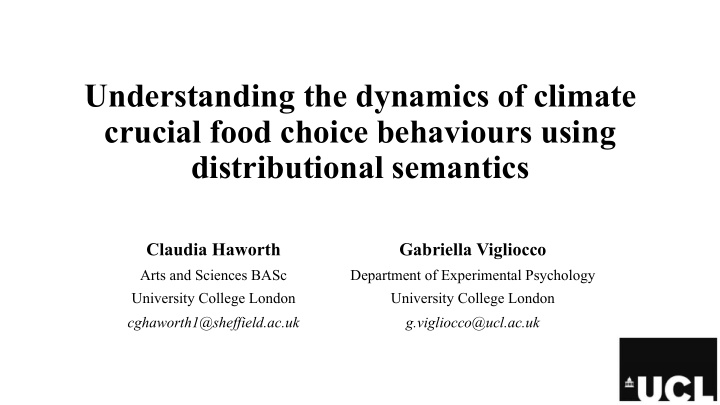



Understanding the dynamics of climate crucial food choice behaviours using distributional semantics Claudia Haworth Gabriella Vigliocco Arts and Sciences BASc Department of Experimental Psychology University College London University College London cghaworth1@sheffield.ac.uk g.vigliocco@ucl.ac.uk
The agricultural sector contributes around one quarter of total global emissions. 80% of these emissions are livestock related. (IPCC, 2014, McMichael et al., 2007, IPCC, 2019).
2019 IPCC report on Land Use highlights dietary change as an important strategy for mitigation and adaptation “very high” mitigation potential (p.60) - between 0.7 and 8.0 GtCO 2 -eq/yr (p.58) - Technical Summary (IPCC, 2019) “supply-side adaptation measures alone will not be sufficient to sustainably achieve food security under climate change” (p.472) - ‘Chapter 5: Food Security’ (IPCC, 2019) “Achievement of this potential at broad scales depends on consumer choices and dietary preferences that are guided by social, cultural, environmental, and traditional factors” (p.58) - Technical Summary (IPCC, 2019)
The missing knowledge Not enough is known about why we eat what we eat Essential knowledge to create change
Traditional methods aren’t sufficient Too resource intensive: need lots of data to create generalisable results that are useful to policymakers Focus is on explicit factors that influence food choice What about implicit influences? “Achievement of this potential at broad scales depends on consumer choices and dietary preferences that are guided by social, cultural, environmental, and traditional factors”
Studying mental representations of foods How does the brain represent food concepts? How are food concepts organized and associated with other foods, and other things? Standard practice in psycholinguistics to use a Distributional Semantic Model for semantic memory (Jones et al, 2015)
Our methods – model We start with Skip-gram word embeddings (Mikolov et al, 2013) since they give a good approximation to human performance Figure from Mikolov et al (2013)
Our methods – data Constructing a meaningful model of semantic memory requires the right training data : Baroni et al (2007) Enough high-quality examples of UK English that are representative of UK culture varied content extracted from .uk web domains extensively linguistically post-processed ~2 billion tokens from ~3 million documents
Our methods – seed words Appendix R to the National Diet and Nutrition Survey (PHE, 2018) cross-referenced with with WordNet (Princeton University, 2010) and BBC Food ( n = 925 terms) frequency < 20 removed high frequency polysemic (i.e. ‘date’, ‘Turkey’) removed 14 Native English speakers were consulted over removal of words of more ambiguous polysemy (i.e. ‘roll’, ‘chop’) final list n = 640 terms
Research questions 1. How are foods mentally represented? 2. How does affect (i.e. emotional association) vary between foods? 3. How do descriptive features vary across foods?
1. How are foods mentally represented? *Note this is not all the words we used as it was impossible to fit them all in one readable graph!
2. How does affect (i.e. emotional association) vary between foods?
3. How do descriptive features vary across foods?
Summary of results UK mental representations of food concepts divide into three categories – Fish and Seafood, Edible Plants, and Miscellaneous (including Meat, Animal Derivatives and Sweet Foods) The Miscellaneous category has on average higher associated affect than the other categories Hedonic language is associated only with foods in the Miscellaneous category Meat substitutes (i.e. tofu) appear as part of the Edible Plants category The Fish category has lower associated affect, and its descriptive features show a lack of familiarity with Fish as a food
People in the UK have an implicit idea that meat is the centre of the meal both historically, and today (see Yates and Warde (2015)) “It’s not a meal without meat” Macdiarmid et al (2017, p.491)
Future research using this method This method has promise Studying the UK, we see Fish and Seafood as a separate, non-food category “I’m having fish for dinner” is a very natural thing to say in UK English But we wouldn’t expect this in Japan! Suggests the method is capturing implicit and explicit cultural information
Future research using this method Our corpus was from 2007 Has there been a genuine cultural shift? Is it just a trend? Longitudinal studies using corpora from a variety of time-points could measure effectiveness of policy etc
Understanding the dynamics of climate crucial food choice behaviours using distributional semantics Claudia Haworth Gabriella Vigliocco Arts and Sciences BASc Department of Experimental Psychology University College London University College London cghaworth1@sheffield.ac.uk g.vigliocco@ucl.ac.uk @cghaworth @vigliocco_g
Recommend
More recommend